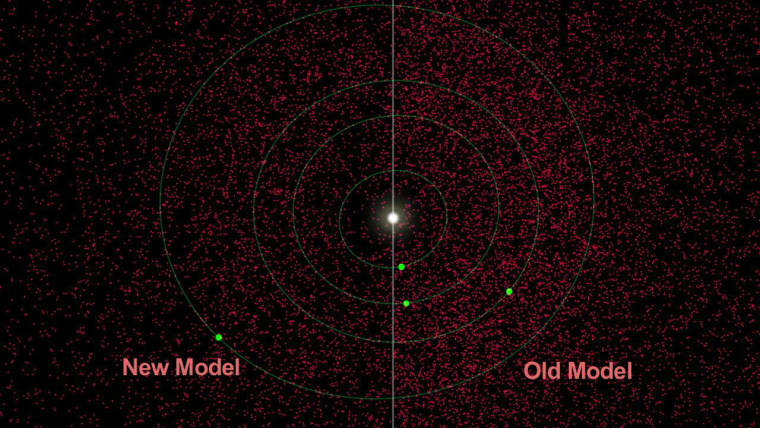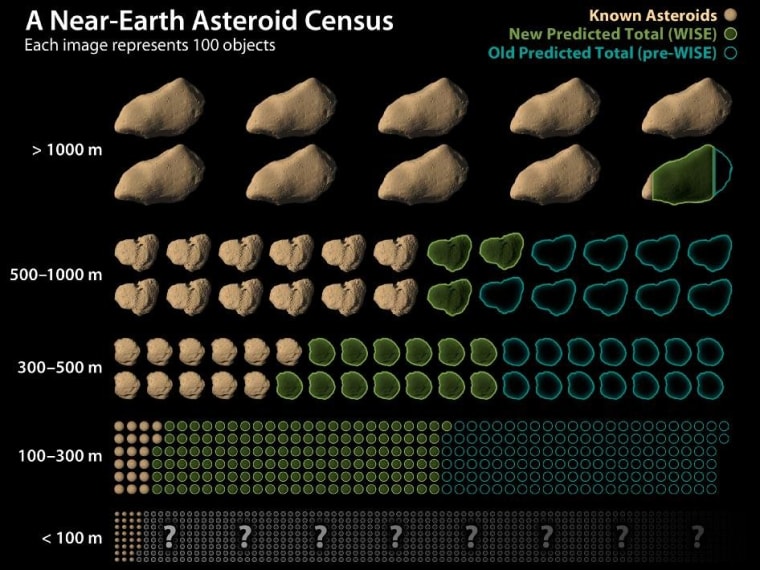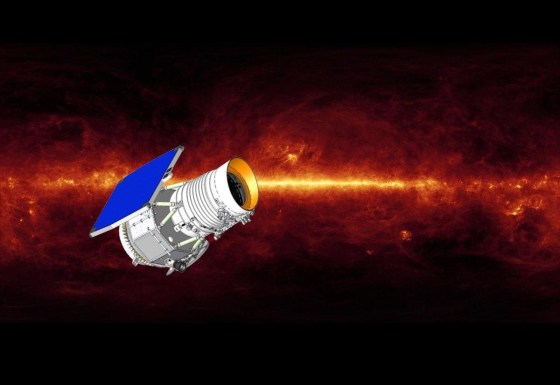Scientists laid out the results of an all-sky asteroid survey conducted by NASA's Wide-field Infrared Survey Explorer, or WISE. Sorry, no Planet X has been discovered yet ... which is good news, come to think of it. "Planet X is not coming to get us," said Amy Mainzer, principal investigator for the probe's NEOWISE mission.
The even better news is that there appear to be significantly fewer threatening near-Earth objects than previously thought. "We believe that the hazard to the earth may be somewhat less," Mainzer. an astronomer at NASA's Jet Propulsion Laboratory, reported today during a news briefing at NASA Headquarters in Washington.
Mainzer and her colleagues shared all this good news after taking the most accurate census to date of the asteroids in Earth's orbital vicinity, within 120 million miles (195 kilometers) of the sun. Results from NEOWISE (which stands for Near-Earth Object WISE) are being published in The Astrophysical Journal, with Mainzer as lead author.
WISE was launched in 2009 to scan the full sky twice in infrared wavelengths, which provide a clearer picture of dark asteroids than visible-light observations — just as infrared-sensing goggles improve a soldier's night vision on Earth.
The space telescope observed more than 100,000 asteroids in the main belt between Mars and Jupiter, plus at least 585 near Earth. That sampling was sufficient to produce an estimate of how many asteroids of various sizes exist in the target area — just as a population census provides a good demographic picture even though the census-takers didn't knock on every door.

Mainzer said the WISE results confirmed that astronomers worldwide "have now found more than 90 percent" of the near-Earth asteroids that are wider than a kilometer (0.6 miles). That's the sort of space rock that scientists believe could create a mass-extinction event of the type that killed off the dinosaurs 65 million years ago. The NEOWISE team's computer model suggests that there are 981 of such asteroids, compared with previous estimates of around 1,000. Astronomers currently have identified 911 of these "planet-buster" asteroids, none of which pose a threat to Earth over the next few centuries.
The 90 percent figure is important because Congress specified that figure in 1998 as the initial goal for NASA's Spaceguard program.
"The risk of a really large asteroid impacting the Earth before we could find and warn of it has been substantially reduced," Tim Spahr, the director of the Minor Planet Center at the Harvard Smithsonian Center for Astrophysics, said in NASA's news release.
However ... there's another category of bad-news asteroids, ranging in size from 100 meters (330 feet) to a kilometer in width. These midsize rocks could wipe out a metropolitan area or create a "cosmic Katrina" if they were to hit in just the wrong place. The NEOWISE team estimated that there are 19,500 of such rocks in the near-Earth zone.
The good news is, that's a significantly smaller figure than previous estimates of 35,000 midsize near-Earth objects. The bad news is, astronomers are currently tracking 5,500 asteroids in that size range, which suggests that 14,000 or so remain to be detected. And there are an estimated million asteroids smaller than 100 meters capable of causing lesser amounts of damage if they were to blast through Earth's atmosphere.
In 2005, Congress revised the Spaceguard Survey's initial goal to call on NASA to find 90 percent of the near-Earth objects that are at least 140 meters (460 feet) wide, and Mainzer said tracking down all those rocks is "going to keep us busy for a long time."
"NEOWISE was just the latest asset NASA has used to find Earth's nearest neighbors," Lindley Johnson, program executive for the Near Earth Object Observation Program at NASA Headquarters, said in today's release. "The results complement ground-based observer efforts over the past 12 years. These observers continue to track these objects and find even more."

During today's briefing, Johnson said the results of asteroid surveys would feed into NASA's plans to send astronauts to a near-Earth asteroid sometime in the mid-2020s. In fact, the asteroids that come closest to Earth and pose more of a potential threat would be of "particular interest for exploration destinations," he said.
As for Planet X, or Nibiru, or Nemesis ... Mainzer said there's not been any sign of a large object that could bring about a doomsday in 2012 or anytime soon. "We don't think that there's anything hazardous in the outer solar system," she said.
But that doesn't mean there's nothing interesting out there. Mainzer pointed out that the $320 million WISE mission has already detected 100 brown dwarfs in Earth's vicinity, including some of the coldest brown dwarfs ever seen. Although the WISE spacecraft was shut down earlier this year, the data analysis continues, and there's still a chance that other strange cosmic objects could come to light.
"We're still working on that now," Mainzer said.
More about asteroids:
- Hunt for new worlds goes into overdrive
- Interactive: The new solar system
- Asteroid early-warning system proposed
- Interactive: Close encounters of the asteroid kind
Last updated 5:42 p.m. ET.
Connect with the Cosmic Log community by "liking" the log's Facebook page, following @b0yle on Twitter or adding me to your Google+ circle. You can also check out "The Case for Pluto," my book about the controversial dwarf planet and the search for other worlds.
